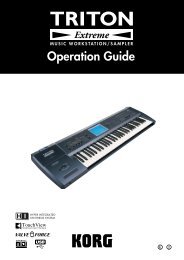Breedlove Owner's Manual - zZounds.com
Breedlove Owner's Manual - zZounds.com
Breedlove Owner's Manual - zZounds.com
You also want an ePaper? Increase the reach of your titles
YUMPU automatically turns print PDFs into web optimized ePapers that Google loves.
Generally, a properly adjusted truss rod results in a neck with slight forward<br />
relief. To check for proper neck relief, push down on the low “E” string<br />
at the 1st and 14th frets simultaneously. There should be about 0.010” of<br />
space between the bottom of the string and the top of the 6th fret - about the<br />
thickness of a business card. You may want a larger or smaller amount of<br />
relief depending on your playing style.<br />
!<br />
Truss Rod Adjustments for U.S. Custom Shop Revival Series Guitars<br />
To adjust the single-action truss rod on a Revival Series instrument, you will<br />
need a round-tipped 5/32” Allen wrench that is at least 4” long (a special<br />
Revival Truss Rod Wrench is available from <strong>Breedlove</strong> - please contact us for<br />
details). The adjustment nut is located inside the soundhole, toward the neck.<br />
It is very close to the top of the guitar, and right underneath the fingerboard.<br />
Newer Revival instruments have an access hole through the top soundhole<br />
brace, while older instruments do not. If you do not have an access hole,<br />
note that one of the two neck bolts is also in this general area. The top neck<br />
bolt can be seen through the soundhole, while the truss rod nut is not visible<br />
unless you have the access hole. If you can see your wrench going into a<br />
large bolt, you’re in the wrong place! To access the adjustment nut, insert the<br />
wrench into the soundhole between the D and G strings (holding them apart<br />
can be helpful) and point it up toward the area described above to find the nut.<br />
Turn clockwise to tighten the truss rod, or counterclockwise to loosen it.<br />
Note: The Truss Rod should only be adjusted in order to establish proper<br />
neck relief and to counteract/balance the effect of string tension. Do not use<br />
the Truss Rod adjustment feature to try to correct larger set-up issues or other<br />
problems that are not related to neck relief.<br />
6

















